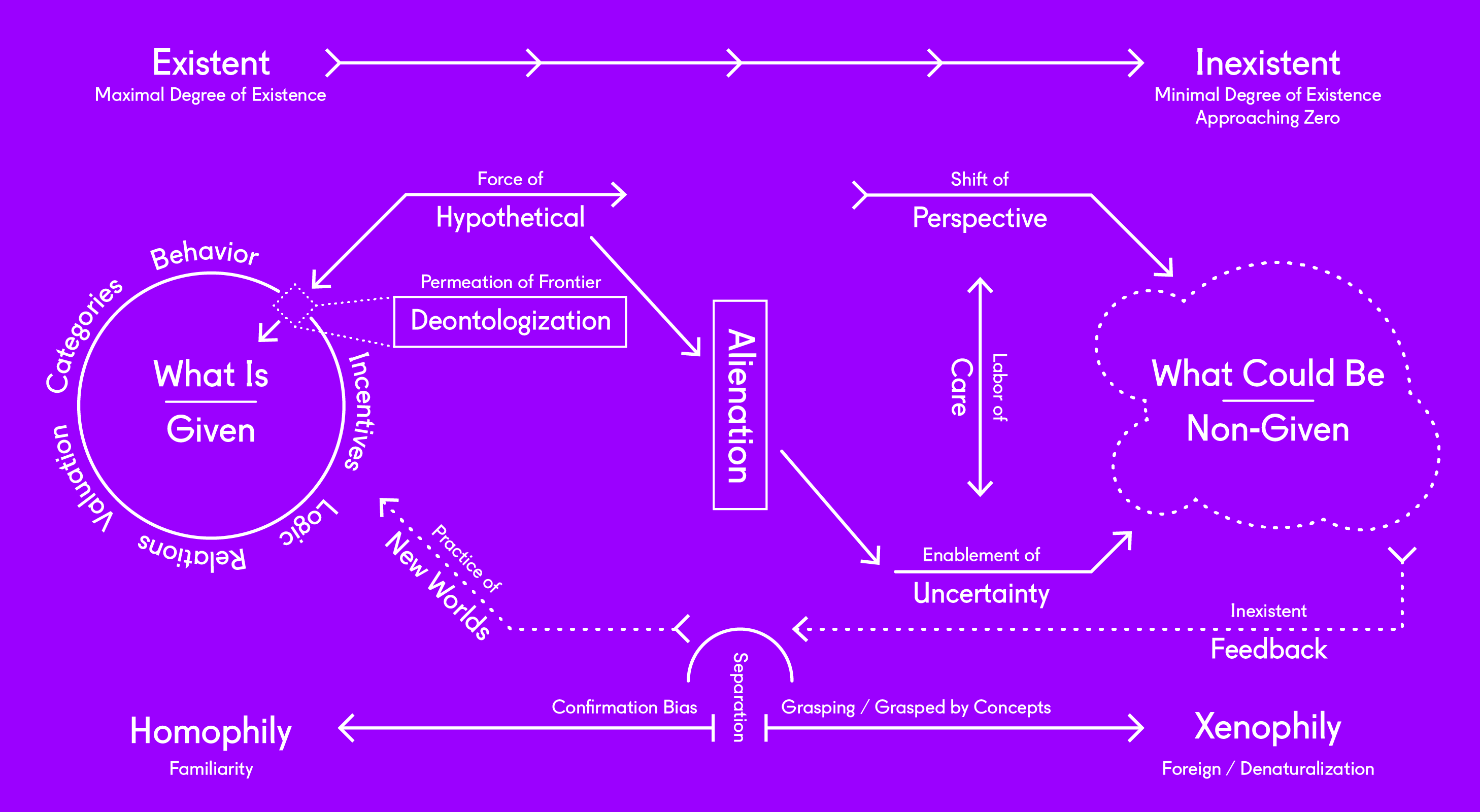Sebastian Olma, In Defense of Serendipity: For a Radical Politics of Innovation (London: Repeater Press, 2016). Solutionism, as Evgeny Morozov identifies it, essentially turns all problems into techno-scientific ones, rather than social, normative or governmental ones. Ian Tucker, “Evgeny Morozov: ‘We are abandoning all the checks and balances’” in The Guardian, 9 March, 2013, ➝.
For an account of Wilfrid Sellars’ “Myth of the Given” see “Slaves to the Given”, >ect 8, Podcast, ➝.
Ray Brassier, “The View from Nowhere”, in Identities: Journal of Politics, Gender and Culture Vol. 8, No. 2, Summer 2011, 6–23.
That conceptual predispositions are baked into our increasingly automated, computationally driven reality, reveals a contingent parity between the techno-scientific domains (STEM) and the humanities that demands leveraging. This constitutive parity, between disciplines of knowledge, does not mean, however, that they factor equally, socially or economically as anyone trying to fund an arts/humanities program can attest. Much like the axiom of equality Jacques Rancière puts forth in Disagreement, where he claims that the only way there is order in society is because there are those who give commands, and those who obey those commands; but crucially, for this structure of dominance to perpetuate, one needs to understand the command and understand that one must obey it – and this, he asserts, is the necessary contingency of ‘equality’ at the root of inequality. Politics, as such, is when this contingency of equality is claimed and made actionable as the demonstration of parity. Although Rancière’s formulation concerns exclusively human agents, the concept remains useful to extrapolate upon knowledge domains finding themselves powerless, merely ‘obeying’ the commands of STEM as institutions of knowledge optimize for competitive relevance – an adaption only fitting the organization of what is. See: Jacques Rancière, Disagreement: Politics and Philosophy, trans. Julie Rose, (Minneapolis: University of Minnesota Press, 1999) 16.
Claire Lehmann, “Color Goes Electric”, in Triple Canopy Issue #22, May 2016, ➝.
Helen Hester, “Technically Female: Women, Machines and Hyperemployment”, Salvage, August 2016, ➝.
Walter Kaufmann, “The Inevitability of Alienation” in Richard Schacht, Alienation (London: George Allen and Unwin Ltd., 1971) xiii-xvi.
The concrete assumes the abstract as a condition of its enablement, which is to say there is always a dynamic imbroglio between the territory and the map, materiality and ideality. See Ray Brassier, “Prometheanism and Real Abstraction”, in Speculative Aesthetics (Falmouth: Urbanomic, 2014) 72-77, and Glass Bead, “Castalia, the Game of Ends and Means” editorial, in Glass Bead Journal, Site 0, February 2016, ➝.
Donna J. Haraway, Staying with the Trouble: Making Kin in the Chthulucene (Durham: Duke University Press, 2016).
Mark Fisher, Capitalist Realism: Is There No Alternative? (London: Zero Books, 2009), 66.
See: Keller Easterling, Extrastatecraft: The Power of Infrastructure Space (London: Verso, 2015); Alberto Toscano, “Logistics and Opposition” in Mute, Vol 3., No. 2 (2011), ➝; Benjamin H. Bratton, The Stack: On Software and Sovereignty, (Cambridge: MIT Press, 2015).
Jeffrey Kluger, “Senator Throws Snowball! Climate Change Disproven!” in Time, 27 February 2015, ➝.
Ibid., Brassier, 2011.
Wendy Hui Kyong Chun, “On Hypo-Real Models or Global Climate Change: A Challenge for the Humanities” in Critical Inquiry, Vol. 41, No. 3 (Spring 2015), (Chicago: Chicago University Press), 675-703.
Mario Carpo, “The Alternative Science of Computation”, in Artificial Labor (e-flux Architecture, 2017), ➝.
Stathis Psillos, ‘An Explorer upon Untrodden Ground: Peirce on Abduction’, in Handbook of the History of Logic Volume 10, eds. John Woods, Dov Gabbay and Stephan Hartmann. (Amsterdam: Elsevier, 2011), 115-148.
Ibid., Bratton, 348.
Wendy Hui Kyong Chun, “The Middle to Come”, Panel discussion, transmediale: ever elusive, Berlin, 5 February, 2017.
Miller McPherson, Lynn Smith-Lovin, and James M Cook, “Birds Of A Feather: Homophily in Social Networks”, in Annual Review of Sociology Vol. 27, August 2001, 415-444.
Ibid., Kaufmann.
Artificial Labor is collaborative project between e-flux Architecture and MAK Wien within the context of the VIENNA BIENNALE 2017.
